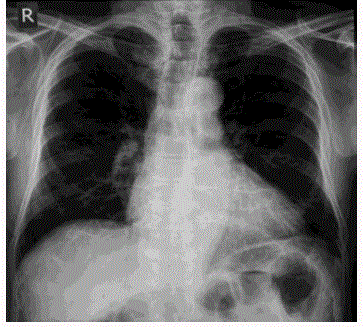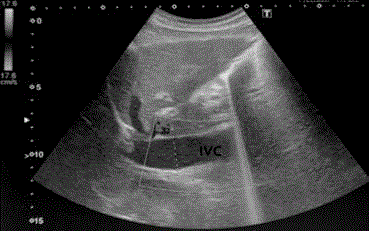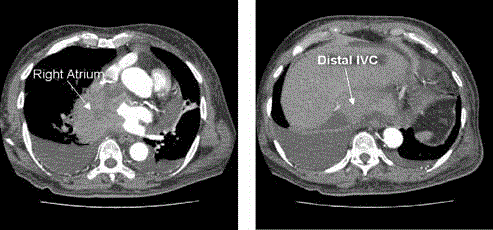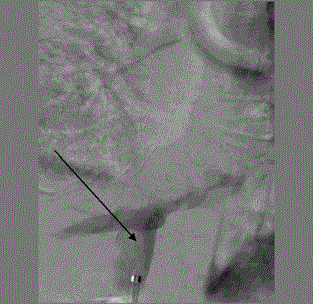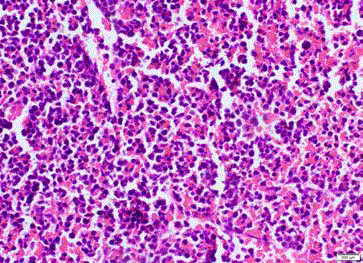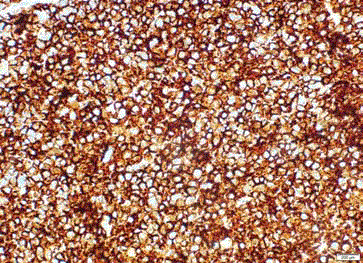Case Report
Lymphoma Involving the Heart and Inferior Vena Cava: Radiological and Pathological Approach
Duminda WD1*, Pathirana KG2, Lekamge IN1, Weerakoon S1, De Silva YAP1, Ganewatte E1, Appuhamy WNDPC1, Parthipan N1, Senadeera RL1, Jayawickrama M3 and Gayani GHP3
1Department of Radiology, The National Hospital of Sri Lanka, Sri Lanka
2Department of Radiology, The Lady Ridgeway Hospital for Children, Sri Lanka
3Department of Histopathology, The National Hospital of Sri Lanka, Sri Lanka
*Corresponding author: Duminda WD, The National Hospital of Sri Lanka, E W Perera Mawatha, Colombo 00700, Sri Lanka
Published: 24 Apr, 2017
Cite this article as: Valentino MA, Saxena S, Vira A, Tecce
M. Propionibacterium acnes Infection
of a Mitral Annuloplasty Ring. Ann Clin
Case Rep. 2017; 2: 1343.
Abstract
Primary cardiac lymphoma (PCL) is a very rare condition accounts for 2% of all primary cardiac tumours. This is a case report of a 76 year old male patient with shortness of breath, cough and pyrexia of unknown origin for 2 months. In the initial diagnostic workup, echocardiography revealed aortic and mitral regurgitation with no pericardial effusion. With the development of right sided pleural effusion about one month after the initial presentation, ultrasound scan guided pleural fluid aspiration performed. Pleural fluid culture revealed no bacterial growth. Second echocardiography showed no flow in the superior vena cava (SVC) and suspected of a thrombus. Contrast enhanced Computed Tomography scan of the chest demonstrated a mass lesion in the right heart and distal inferior vena cava (IVC). The lesion was compressing the SVC without complete obstruction. The pericardium was intact with no pericardial effusion. No mediastinal lymphadenopathy identified. Initial differential diagnosis was leiomyosarcoma of the distal IVC extending in to the right heart. As there was no pericardial involvement, possibility of lymphoma was made as a remote cause. Subsequently digital subtraction angiography guided biopsy performed from the mass in the distal IVC and right atrium. Diffuse lymphoma was confirmed on histology. As there were no Hodgkin cells in the sample, probable diagnosis of Non-Hodgkin’s lymphoma was made. Subsequently patient died due to cardiovascular compromise before starting specific therapy.
Keywords: Cardiac lymphoma; Inferior vena cava; Radiological imaging; Histological diagnosis
Introduction
Primary cardiac lymphoma (PCL) is a very rare condition usually of B-cell non-Hodgkin’s type. They account for 2% of all primary cardiac tumours and 1% of extranodal lymphomas [1,2]. They are usually diffuse large cell lymphomas manifest as an ill-defined, infiltrative mass [3]. PCL are more commonly seen in immunocompromised states, either iatrogenic including those associated with solid organ or bone marrow transplantation or HIV related and these are usually associated with EBV infection. Lymphomas in immunocompetent individuals are extremely rare [4]. As there are no specific clinical symptoms, the clinical diagnosis of the condition is difficult. Typically when B symptoms develop, (fever, weight loss, fatigue common in lymphoid malignancies), progressive heart failure will ensue in these patients [5]. However advanced cross sectional imaging modalities allowed early and accurate detection of primary cardiac malignancies [6]. The definitive diagnosis of the condition needs histological evaluation of the tumour. One of the accessible diagnostic methods is transesophageal echocardiography -guided transjugular biopsy, which has a relatively low risk of complications [7]. Endomyocardial biopsy via percutaneous cardiac approach is also another approach for histological diagnosis [8]. We present a case of lymphoma arising in the heart with extension in to the superior and inferior vena cava.
Case Presentation
A 76 year old male was initially investigated for shortness of breath and cough of 2 months
duration in a specialized hospital for respiratory disease. On initial presentation the patient was
not dyspnoeic but found to have 94% of saturation of oxygen in blood. Bilateral ankle oedema
was evident at that time (Figure 1). The blood pressure was normal on admission to the hospital.
During hospital stay patient develops mild fever episodes intermittently. Sputum culture and blood
culture were negative during the febrile illness. Subsequently patient underwent transoesophageal echocardiography suspecting infective endocarditis, and it revealed
grade ii aortic regurgitation and mitral regurgitation (Figure 2). There
was no evidence of pericardial effusion or features of congestive
cardiac failure.
About a month following initial presentation the patient develops
right sided pleural effusion and then ultrasound scan guided pleural
fluid aspiration was performed (Figure 3 a and b). There were 3.8g/
dl of protein and 80% of lymphocytes in the pleural fluid. However
there was no evidence of bacterial growth or acid fast bacilli in the
pleural fluid.
Again patient was send for cardiology opinion and underwent 2
dimensional Echocardiogram which revealed no flow in the superior
vena cava (SVC) with suspicion of a thrombus in the SVC extending
in to the right ventricle (Figure 4). Right atrium was dilated at that
time. Then the patient was transferred to the National Hospital of Sri
Lanka (NHSL) for further evaluation and management.
A contrast enhanced Computed Tomography (CT) scan of the
chest performed in the NHSL and detected a contrast enhancing
mass lesion with few hypodense areas within the lesion involving the
distal inferior vena cava (IVC), right atrium and right ventricle. The
lesionn was appearing to compress the distal SVC without complete
obstruction of the lumen. Right main pulmonary artery was pushed
superiorly by the mass lesion without significant luminal narrowing.
The pericardium was not involved by the lesion and there was no
pericardial effusion. There was bilateral pleural effusion on CT scan.
There was no significant hilar or mediastinal lymphadenopathy. In
conclusion differential diagnosis of leiomyosarcoma of the distal
IVC extending in to the right atrium and right ventricle was made.
As there was no pericardial effusion or pericardial involvement by
the mass lesion, the possibility of lymphoma was made as a remote possibility.
Subsequently the patient referred for digital subtraction
angiography guided biopsy of the mass lesion in the distal IVC and
right atrium. With right femoral vein puncture the venous access
gained and IVC catheterization was performed. Five biopsy samples
were obtained using 10 F guiding catheter and an Alligator forcep.
On histological assessment with haematoxylin and eosin staining
there were sheets of discohesive medium to large lymphoid cells
with enlarged hyperchromatic nuclei and narrow rim of cytoplasm.
Mitoses were frequently found. Immunohistochemistry (IHC) with
Leukocyte Common Antigen (LCA) revealed strong membranous
positivity in all lymphocytes (Figures 5 and 6). Diffuse lymphoma was
confirmed by histology. As there were no Hodgkin cells in the biopsy,
probable diagnosis of Non-Hodgkin type lymphoma was made.
Subsequently the patient was transferred to The National Cancer
Institute, Sri Lanka for further management. However the patient
died from cardiac arrest before starting specific therapy.
Figure 1
Figure 2
Figure 2
Longitudinal section through the inferior vena cava on ultrasound
scan showing no demonstrable flow within the IVC.
Figure 3
Figure 3
Contrast enhanced Computed Tomography images showing
irregular filling of the right side heart chambers and distal IVC. a) Mass lesion
in the right heart chambers. b) Mass lesion appears in the distal IVC.
Figure 4
Figure 4
Incomplete filling identified within the distal IVC during digital
subtraction inferior venocavography.
Figure 5
Figure 5
Haematoxylin and Eosin staining showing sheets of discohesive
medium to large lymphoid cells with enlarged hyperchromatic nuclei and
narrow rim of cytoplasm.
Figure 6
Figure 6
Immunohistochemistry (IHC) with Leukocyte Common Antigen
(LCA) revealed strong membranous positivity in all lymphocytes.
Discussion
Primary cardiac lymphoma (PCL) is a very rare condition. On
histology they are usually of B-cell non-Hodgkin’s type lymphoma.
The most frequent location of PCL is the right atrium, followed by the
pericardium. Signs and symptoms are non-specific and depend on
the location and extent of the tumor; these include right-sided heart
failure precordial pain, arrhythmias, conduction disorders and cardiac
tamponade [7]. In literature there is a case of atypical presentation of
ischemic hepatitis in a young adult with PCL, which highlights the
wide variety of clinical manifestations of this rare tumour [9]. In
our patient the initial presentation was nonspecific and the disease
progressed rapidly. Radiological imaging played major role in the
identification and sampling of the tumour. The diagnosis of diffuse
lymphoma was confirmed by histology with probable diagnosis of
Non-Hodgkin lymphoma.
The most effective treatment method for cardiac lymphoma
is chemotherapy. Palliative surgery may be necessary to correct
haemodynamics when venous blood flow to the lungs is disturbed
[10]. Guilherme HO et al. [11] concluded in their study that cardiac
lymphomas had worse survival compared with extra-cardiac
lymphomas.
Unfortunately this patient died due to cardiovascular compromise
before starting chemotherapy or palliative surgery.
Conclusion
References
- Fernandes F, Soufen HN, Ianni BM, Arteaga E, Ramires FJ, Mady C. Primary neoplasms of the heart. Clinical and histological presentation of 50 cases. Arq Bras Cardiol. 2001; 76: 231-7.
- Lam KY, Dickens P, Chan AC. Tumors of the heart. A 20-year experience with a review of 12,485 consecutive autopsies. Arch Pathol Lab Med. 1993; 117: 1027-31.
- Jean Jeudy, Jacobo Kirsch, Fabio Tavora, Allen P Burke,Teri J Franks, Tan-Lucien Mohammed, et al. From the Radiologic Pathology Archives, Cardiac Lymphoma: Radiologic Pathologic Correlation. RadioGraphics 2012; 32:1369-80.
- Bagwan IN, Saral Desai, Andrew Wotherspoon, Mary N Sheppard. Unusual presentation of primary cardiac lymphoma. Interactive CardioVascular and Thoracic Surgery. 9; 2009; 127-9.
- Shah K, Shemisa K. A “low and slow” approach to successful medical treatment of primary cardiac lymphoma. Cardiovasc Diagn Ther. 2014; 4: 270-3.
- Seok JR, Byoung WC, Kyu OC. CT and MR findings of primary cardiac lymphoma: Report upon 2 cases and review. Yonsei Medical Journal. 2001; 42: 451-6.
- Angela FC, Felipe Hernández Hernández, Rafael Salguero Bodes, Ignacio Sánchez Pérez , Amparo Carbonell Porras Juan Tascón Pérez. Primary Cardiac Lymphoma: Diagnosis by transjugular biopsy. Rev Esp Cardiol. 2003; 56:1141-4.
- Jung Yeon Chin, Mi Hyang Chung, Jin Jin Kim, Jae Hak Lee, Ji Hyun Kim, Il Ho Maeng, et al. Extensive primary cardiac lymphoma diagnosed by percutaneous endomyocardial biopsy. J Cardiovasc Ultrasound. 2009; 17:141-4.
- Yuan J.S., et al. Acute ischemia hepatitis as a major clinical presentation of the primary cardiac lymphoma. J Emerg Crit Care Med. 23; 3: 2012.
- Karolis Jonavicius, Kestutis Salcius, Raimundas Meskauskas, Nomeda Valeviciene, Virgilijus Tarutis, Vytautas Sirvydis. Primary cardiac lymphoma: two cases and a review of literature. Journal of Cardiothoracic Surgery. 2015; 10: 138.
- Oliveira GH, Al-Kindi SG, Hoimes C, Park SJ. Characteristics and Survival of Malignant Cardiac Tumors: A 40-Year Analysis of Over 500 Patients. Circulation. 2015; 132: 2395-402.

